Basics of Solvent Use in Freeze Dryers
Freeze dryers were originally designed and developed for use with water as the primary and only solvent. Today, it is not unusual to see inorganic acids and bases utilized as solvents, creating complications for standard freeze dryers. Many freeze dryers utilize acrylic doors and elastomers (gaskets and seals) that will have limited resistance to organic solvents and stainless-steel components may react adversely to inorganic solvents.
These solvents typically have a high vapor pressure and come out of the product very early in the primary drying phase of the freeze drying cycle. To safeguard against damage to the freeze dryer components and help ensure product quality, it is important to understand the material compatibility of all solvents present in your product, regardless of the amount. Material compatibility charts can be found online. Sites such as http://www.coleparmer.com/Chemical-Resistance for 304 and 316 Stainless Steel and http://www.eplastics.com/Plastic/plastics_library/Chemical-Resistance-of-Plexiglass-Acrylic for information on acrylic compatibility.
Organic Solvents in Laboratory Freeze Dryers
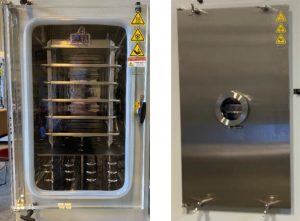
Examples of Millrock Technology Acrylic and Stainless Steel Doors on Laboratory Scale
As mentioned in the previous paragraph, many laboratory freeze dryers are built with acrylic doors on both the condenser and the product chamber. This is done primarily for easy visual access to the product sitting on the shelves as well as being able to watch condenser loading. In the presence of organic solvents in the vapor stream or in the condensate, acrylic will begin to be destroyed. Often this destruction will start with what is referred to as “etching”. The interior of the door will start to take on the appearance of etched glass in some locations. Minor etching will eventually lead to door warping which will create door seal issues. Eventually, as more runs with solvents occur the etching will eventually turn into a hair line fracture. This fracture will make pulling a vacuum virtually impossible and, in the worst-case scenario, may result in implosion of the acrylic component.
The number one priority is to minimize contact between the organic solvent and the acrylic. Check the freezing point of the solvent. If the temperature is above -85C, most of the solvent will be caught on the surface of the condenser, when the condenser is -85C or lower.
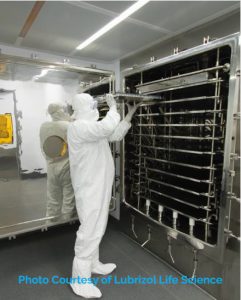
Example of a Millrock Technology Production Scale Unit in Use
Many organic solvents have lower freezing points than the condenser surface temperature. When this is the case, the solvent vapor may liquefy in condenser. While this may help prevent a rush of organic solvent to the vacuum pump, it may lead to accelerated etching of the condenser end plate. Also, given a higher vapor pressure condition, the liquefied solvent my return to the vapor phase and migrate to the vacuum pump in a process referred to as “reflux.”
Important Note: Many freeze dryers use a “smooth surface” condenser, where the temperature sensor is gauging the refrigerant rather than the condenser surface. In contrast, Millrock Technology’s exposed coil condensers enable a direct, accurate reading of the condenser itself. If you are measuring the refrigerant temperature you will need to step up the temperature to calculate a more accurate condenser surface temperature reading.
The frequency and amount of exposure to organic solvents will directly impact the extant of etching and risk.
Tips for All Freeze Dryers:
- A small amount of etching in a laboratory freeze dryer may not create a problem. Monitor the acrylic components for damage, replace components as needed, and wash the freeze dryer thoroughly after each cycle.
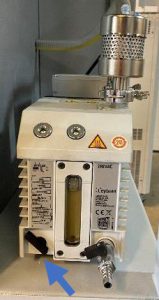
Vacuum Pump Ballast
- A waterline mark on the condenser door can be a telltale sign of solvent in the condensate during the defrost cycle. Conduct the defrost cycle as quickly as possible and do not allow condensate to sit in the condenser chamber. Liquified solvent generally etch acrylic faster than vaporized solvent. If possible, conduct the condenser defrost with the drain open and acrylic door off.
- If the acrylic components of your lab freeze dryer are compromised quickly, they should be replaced with stainless steel components. Stainless steel doors should normally be equipped with at least one sight glass.
- Solvents will often “flash off” in the first part of the freeze drying cycle, after the vacuum pump is activated creating higher pressure in the freeze dryer. If this is the case, it is usually best to run the vacuum pump with the gas ballast open during the “flash off.” Considerations to exhaust the solvent in a safe manner should be taken. After the “flash off” it is usually best practice to close the ballast for better performance and less vacuum oil degradation.
- While it may result in decreased system performance, the entire vacuum pump can be placed in a safety cabinet. Another alternative is to put a non-restrictive line on the output of the vacuum pump. The line should be lower than the pump exhaust and may include a trap to catch any solvent that can condensate and run back toward the pump.
- A liquid nitrogen trap can be installed between the condenser and the vacuum pump. After the high pressure solvents flash off, the trap should be taken offline to lessen the use of nitrogen and help ensure that the solvent will not warm, vaporize and run back to the pump.
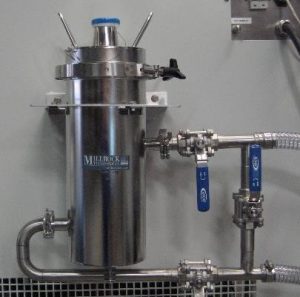
Liquid Nitrogen Trap
- If organic solvent use will be consistent, a dry pump may be considered. Dry vacuum pumps, while usually, significantly more expensive than oil pumps, tend to resist solvent damage.
A Few Notes Specific to Manifold Type Freeze Dryers
The joint between the acrylic ports and the body of the manifold is the “weakest” area of a manifold freeze dryer. Make sure that product containers are well supported as heavy product containers can potentially pull the port right out of the manifold body. If you have a vacuum leak while freeze drying, that appears to go away when the system is dry and empty, there may be small leaks at the port-to-manifold-body connections that become leaky when the solvent is present, and reseal themselves when solvent is no longer present.
Inorganic Solvents in Laboratory Freeze Dryers
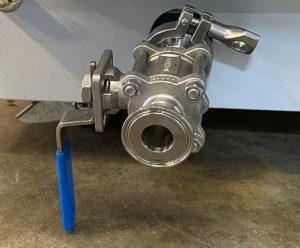
Condenser Drain Port
When inorganic solvents are introduced to laboratory freeze dryers it is important to check the compatibility with the stainless steel of the freeze dryer. 316L, usually used in modern freeze dryers, has higher corrosion resistance in comparison with older systems that may be constructed of 304L.
Inorganic solvents are most likely to attack weld joints first as they are typically the most stressed part of the stainless steel components. If a component becomes compromised, it often results in a vacuum leak that can be difficult to find. If the leak is in a place that undergoes thermal contraction, it may further complicate finding the leak as it may not manifest itself at room temperature.
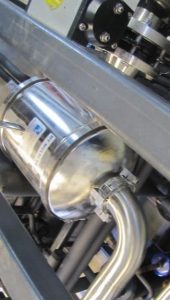
Chemical Trap
Chemical traps can be put in-line between the condenser and the vacuum pump. The most notable is a soda sorb for the absorption of acid. Most freeze dryer manufactures will include acid traps / molecular sieves in their offerings. When using acid traps be aware that soda sorb is hygroscopic. When first put on the freeze dryer, the dryer may not pull to maximum low as it pulls water out of the trap itself. Running the system dry and empty until the max low pressure rating for the system is achieved is recommended. If it is easily done you may want to freeze dry the trap itself prior to putting it online. Also note, that as the soda sorb absorbs acids it will begin to break down and sometimes create a fine dust that may migrate to the vacuum pump. It is a good idea to check your trap before and after each freeze drying cycle.
Good standard operating procedure requires that you understand all the solvents present in your product and to make sure you have verified material compatibility with the freeze dryer components.
In summary:
- Etching and “wear and tear” from the use of small amounts of solvents may be mitigated by good maintenance procedures.
- Have replacement parts on hand installed on regular basis in a time frame that is acceptable to the user.
- Higher amounts of solvents may require alternative construction material.
- Vapor can be ported out the ballast during the “flash off” of organic solvents.
- Liquid nitrogen traps and chemical traps can be used to reduce exposure.
- Dry pumps, while having significantly higher upfront costs may help processes where oil contamination is too frequent.
- In all cases, thoroughly clean the freeze dryer between cycles and give special attention to the condenser drain where solvents may liquify and have prolonged contact.
Copyright © 2020 Millrock Technology

